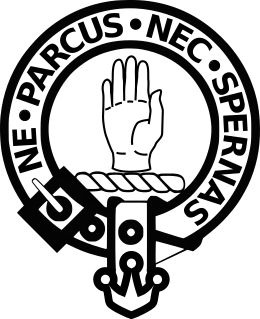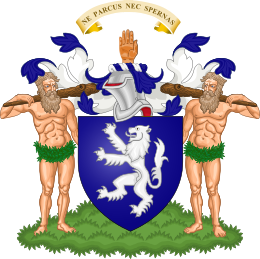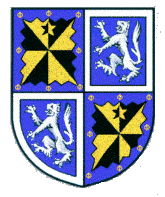Clan Lamont facts for kids
Quick facts for kids Clan Lamont |
|||
|---|---|---|---|
| Clann Laomainn | |||

Crest: A dexter hand couped at the wrist; all proper
|
|||
| Motto | Ne Parcas nec Spernas (Neither spare nor dispose) | ||
| Profile | |||
| Region | Highland | ||
| District | Cowal | ||
| Plant badge | Crab-apple tree, Trefoil, or Dryas | ||
| Chief | |||
 |
|||
| The Rev. Fr. Peter Noel Lamont of that Ilk | |||
| Chief of the Name and Arms of Lamont | |||
| Historic seat | Toward Castle | ||
|
|||
|
|||
|
|||
Clan Lamont is a Highland Scottish clan. A clan is like a large family group, often with a shared history and a chief. The Lamonts are believed to be related to an Irish prince named Ánrothán Ua Néill from the O'Neill dynasty. This means they share a very old family tree with other clans like Clan Ewen of Otter and Clan MacNeil of Barra.
For many centuries, Clan Lamont controlled most of the Cowal peninsula in Argyll, Scotland. However, a terrible event called the Dunoon Massacre in 1646 greatly harmed the clan. During this time, around 200 Lamont clansmen were killed by members of Clan Campbell. After this, many Lamonts moved away, especially to the Scottish Lowlands. Today, you can find Lamonts all over the world, including Canada, Australia, and Britain.
The current chief of Clan Lamont is Rev. Fr. Peter Lamont. He is the 29th chief in his family line. Most Lamonts have remained Catholic over the years.
History of Clan Lamont
The name "Lamont" comes from an Old Norse word, Lagman, which means "Lawspeaker." A Lawspeaker was an important person who knew and explained the laws. The Old Norse word Logmaðr combines "log" (law) and "maðr" (man).
Where Did They Come From?
Around the year 500, a kingdom called Dal Riata moved from Ulster in Ireland to southwestern Scotland. This move was led by the three sons of Erc, the King of Dal Riata. It was during this time that important items like the Stone of Destiny were brought to Argyll. This stone was later used in coronations (crowning ceremonies) for Scottish kings.
An Irish prince named Anrothan O'Neill decided to leave his rule in Ireland and settle in Argyll. From his family line came a powerful lord named Aodha Alainn O'Neil. Aodha had three sons. One son, Lachlan, started Clan MacLachlan. Another son, Neill, founded Clan MacNeil of Barra. The third son, Dunslebhe, had two sons: Ewen, who founded Clan Ewen of Otter, and Fearchar. Fearchar's grandson eventually founded Clan Lamont.
Until the 1200s, Clan Lamont was known as MacKerracher, honoring Fearchar. But in 1235, a man named Sir Laumon signed an important document giving land to Paisley Abbey. From then on, the clan became known as "Lamont." The early chiefs were called "The Great MacLamont of all Cowal."

Battles for Freedom
During the Wars of Scottish Independence, Sir John Lamont, who was the clan chief and Laumon's grandson, supported the MacDougalls against Robert the Bruce. When Robert the Bruce became king, he punished the clans that had opposed him. In 1371, King Robert II gave the Lamonts' traditional home at Dunoon to Sir Colin Campbell, who had supported Bruce.
By the end of the 1300s, Clan Lamont had lost almost all of its original land in Cowal to the Campbells. Even though there were marriages between the two clans, the relationship between Lamonts and Campbells remained difficult.
Trouble with the Campbells
In 1400, some of King Robert II's men caused trouble while the King was away. Lamont clansmen caught these men and killed them. The King was angry and punished Clan Lamont by taking away nearly eight square miles of their land and giving it to the Campbells.
As the Campbells gained more land, they became even bolder in showing their power in Argyll. In 1442, the chief of Clan Lamont allowed the eldest son of Sir Duncan Campbell to be buried at the Kirk of Kilmun. This church was on Lamont land. The Highlands had heavy snowfall, making travel difficult, which led to the request. After this, Campbell asked the Pope to build a church there. The Pope agreed, and Sir Duncan Campbell made it a burial place for Campbell chiefs, which it still is today.
In 1472, Clan Campbell officially received the lands around Dunoon. They then made Dunoon Castle their main home.
Working Together
Despite their strong rivalry, Clan Campbell and Clan Lamont joined forces in 1544. They tried to stop an English attack sailing through the Firth of Clyde into Scotland. King Henry VIII wanted to capture the young Mary, Queen of Scots and have her marry his son. The Campbell and Lamont alliance failed to stop the English, but their fighting gave the Earl of Lennox enough time to take Mary to Stirling Castle and keep the House of Stuart safe.
A Story of Kindness
A famous story about Highland hospitality involves Clan Lamont and Clan Gregor around the year 1600. The son of the Lamont chief and the only son of the MacGregor chief were hunting together. They argued, and Lamont accidentally wounded MacGregor, who later died. Lamont ran away, with MacGregor's angry followers chasing him. He eventually found his way to the MacGregor chief's house.
When the MacGregor chief heard Lamont was in danger, he promised to protect him. Soon, the old MacGregor realized Lamont had killed his own son. But he felt bound by the Highland laws of hospitality. He told Lamont, "Here this night you shall be safe." When the angry MacGregor clansmen arrived, the chief kept his word and protected Lamont. Later, in the dark, the chief personally took Lamont to Loch Fyne and gave him a boat. He told him, "Flee for your life; in your own country we shall pursue you. Save yourself if you can!"
Years later, a poor, ragged man came to Toward Castle asking for shelter. It was MacGregor of Glenstrae, who had lost his lands and was running for his life. The Lamont chief remembered MacGregor's honorable act. He offered MacGregor protection and a home. The old MacGregor lived with Lamont for years until he died. He was buried with honor in the graveyard at the chapel of St. Mary.
The Darkest Time: The Dunoon Massacre
The mid-1600s were a very difficult time for Clan Lamont. The Covenanter wars and the Wars of the Three Kingdoms caused great conflict in Scotland. Clan Lamont first allied with the Campbells, but this period ended with the terrible Dunoon Massacre.
Sir James Lamont was the chief during this time. In 1634, he represented Argyll in Parliament. However, he was secretly supporting the Royalist cause, which angered the Marquess of Argyll, the chief of Clan Campbell.
When the Wars of the Three Kingdoms began, King Charles I ordered Lamont to fight against the rebels, who were the Campbells. Even though Lamont supported the King, he had to join forces with the powerful Marquess of Argyll. After a battle where the Covenanters lost, Sir James was freed. He then joined the Marquess of Montrose and actively supported the Royalists.
Lamont then joined forces with Alasdair MacColla and attacked the lands of the Campbells. Sir James's brother, Archibald, led Lamont forces across Loch Long. They caused great damage in areas controlled by the Campbells, especially in North Cowal. They targeted Dunoon because it had once been a Lamont stronghold that the Campbells had taken. During these attacks, the Lamonts and MacColla's men were very harsh. They attacked the Tower of Kilmun. Even after the tower surrendered with a promise of safety, the prisoners were killed. Sir James Lamont's forces also destroyed much property and took cattle and horses from Strachur.
Several months later, in May 1646, the Campbells attacked the Lamont castles of Toward and Ascog to get revenge. By June 1, 1646, the Campbells used cannons to attack the Lamont strongholds. Two days later, Sir James Lamont agreed to surrender, believing he and his men would be safe. He also convinced the other Lamonts at Ascog Castle to surrender.
However, the Campbells did not keep their promise. They took the surrendered Lamonts to Dunoon by boat. The Lamont castles were then looted and burned. Sir James and his close family were sent to Inveraray Castle, and he was held in the dungeons of Dunstaffnage Castle for five years. At Inveraray, Sir James was forced to sign over all the Lamont lands to Clan Campbell.
In the churchyard at Dunoon, about a hundred Lamonts were sentenced to death and executed. Thirty-six important clan members were killed and buried in a common grave. After years in prison, Sir James Lamont was brought to Stirling Castle in 1651 to answer for his actions with Alasdair MacColla. However, he was spared trial when King Charles II led his forces into England. Lamont was finally released when Oliver Cromwell's forces took Stirling. Cromwell's victory also meant that the "contract" Sir James was forced to sign was no longer valid, and Clan Lamont got its lands back.
In 1661, Sir Colin Campbell, who was a leader in the Dunoon Massacre, was brought to justice. He was found guilty of treason and executed.
After the Uprisings
Even though Clan Lamont kept their lands, they were not as powerful in the 1700s. Their lands in Cowal were surrounded by strong Campbell castles. Because many Lamonts were Roman Catholic, they could not easily travel north to join the Jacobite Rising of 1715 or the Jacobite Rising of 1745. Since the Lamonts did not take part in these uprisings, they were spared the harsh punishments given to other clans. However, the clan system in Scotland was largely ended after the Battle of Culloden in 1746. The British government made laws against bagpipes, tartans, and clan chiefs, which affected all Highland clans.
Lamonts Today
The chiefs of Clan Lamont lived at Ardlamont until 1893. That year, the 21st chief, John Henry Lamont, sold the last of their lands and moved to Australia. The current chief is Rev. Fr. Peter Noel Lamont. He is a parish priest in Marayong, Australia. He is also a member of the Standing Council of Scottish Chiefs, which is an important group for Scottish clans.
A Special Family Branch: Lamont-Campbell of Possil
The Lamont-Campbells of Possil are an interesting example of how the Lamonts sometimes gained from the Campbells. Often, Campbells gained Lamont lands by marrying a Lamont heiress. But with the Lamont-Campbells, it was the other way around. In 1844, the 20th Chief, Archibald James Lamont, married Harriet Campbell of Possil. Their son, Celestine Norman Lamont, inherited Possil in 1858 and became the first Lamont-Campbell of Possil. Adding the Campbell name was a condition of the inheritance. However, this family branch remained Lamonts and were still connected to the chief of Clan Lamont. The Possil estates are north of Glasgow, away from the traditional Lamont lands in Cowal. Mrs. Margaret Lamont-Campbell helped start the Clan Lamont Society in Scotland in 1895.
The Clan Lamont Society
The Clan Lamont Society was started in 1895 in Glasgow, Scotland. Its goal is to keep the clan's values and traditions alive. The main founder was Lieut-Colonel William Belfour Lamont. Since then, the society has grown and now has branches around the world, including Canada, New Zealand, North America, and Australia.
In 1906, the Clan Lamont Society put up a memorial in Dunoon. This memorial is a stone Celtic Cross. It remembers the many Lamonts who were killed in 1646. Every year, the society places a wreath at Dunoon to honor the site. The society also gives the Lamont Shield award at the Cowal Highland Gathering. This award goes to the best young (under 18) piper at the games.
Clan Profile
Chief
- The current chief is The Rev. Fr. Peter Noel Lamont of that Ilk. He is the Chief of the Name and Arms of Lamont.
Crest Badge, Clan Badge, and Music
- Crest badge: This badge shows the chief's heraldic crest and motto.
- Chief's crest: A hand cut off at the wrist, shown naturally.
- Chief's motto: Ne parcas nec spernas (This Latin phrase means "Neither despise nor fear" or "Neither spare nor scorn").
- Clan badge: There are a few plants linked to the clan.
- Crab Apple Tree.
- Dryas (also called Luidh Cheann in Scottish Gaelic).
- March: The clan's march music is called "Captain MacLamont's March" (Spaidsearachd Chaiptein Mhic Laomainn in Scottish Gaelic).
- Lament: A sad piece of music called "The Wanderer's Lament" (Cumha an Fhograich).
- Salute: A welcoming tune called "A Hundred Welcomes to Thee, MacLamont" (Mhic Laomainn ceud failte dhuit).
Tartan
Clan Lamont is closely connected to Clan Campbell, and their tartan shows this. The Lamont tartan looks very similar to the Campbell tartan. The main difference is that the lines in the center of the green sections are white in the Lamont tartan, while they are green in the Campbell tartan. There is an old sample of the Lamont tartan from around 1816 that has the clan chief's seal and signature.

Associated Names
Many surnames are connected to Clan Lamont. Keep in mind that some of these names might also be linked to other clans.
- Aldownie, Aldowny
- Bearden
- Black, Blackie, Blaik, Blaikie, Blake, Blaker, Blakey
- Broun, Brown, Bordon, Burden, Burdon, Burton
- Clement(s)
- Devers
- Green(e)
- Lamb, Lamant, Lambie, Lam, Lammie, Lammon, Lammond, Lamon, Lamond, Lamondson, Lamons, Lamont, Lamonte, Lander(s), Layman
- Learmonth, Leeman, Leemans, Leemon, Lemmon(s), Lemon(s), Lemond, Lemmond, Limon, Limond, Limont, Lhomond, Lomond
- Lucas, Luck, Luckie, Lucky, Luke
- MacAldowie, MacAlduie, MacClammie, MacClammy, MacClement(s), MacCluckie, MacClucky, MacClymont, MacEaracher, MacErcher, MacErracher, MacFarquhar, MacGilledow, MacGillegowie, MacGorie, MacGory, MacGorrie, Mackquein (Aliased as Lamont), MacIldowie, MacIlwham (and Wham), MacIlwhom, MacInturner, MacKerchar, MacKerracher, MacLammie, MacLammy, MacLamond, McLellan, McLeman, MacLemmon, MacLemon, McClemont, McClymont, McLymont, McCliment, MacLimans, MacLucas, MacLuckie, MacLucky, MacLugash, MacLuke, MacLusa, MacLymont, MacMunn, MacPatrick, MacPhunn, MacSorley, MacSurely, McClymonds, McLimans, McLaomainn
- Mecklem, Meickleam, Meickleham, Meikle, Meikleham, Meiklehem, Meiklem, Maiklem, Meiklejohn
- Munn, Munt
- Paters(s)on, Patrick, Phorich
- Sitlington, Sorlie, Sorly
- Toward, Towart, Turner
- White, Whyte
- Young
Images for kids
-
A Victorian era print of the Lamont tartan from The Clans of the Scottish Highlands by R. R. McIan, published in 1845.
See also



